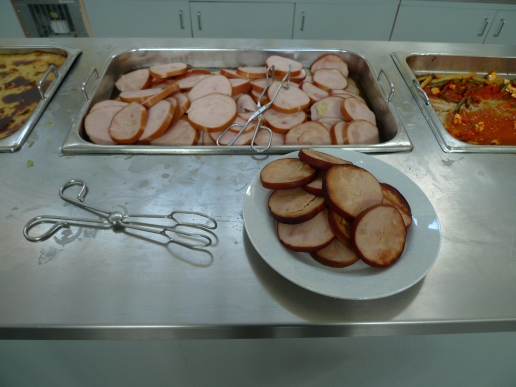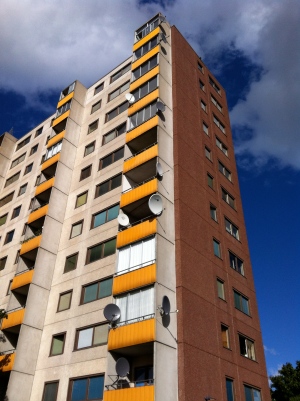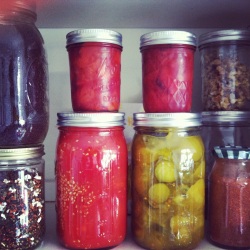School visits with Erik
June 24, 2012
On our next to last day in Fittja, we visited three schools with Erik, the education specialist at Fittja Multi-Kultural Center.
Fittja School
In the first school, Fittja School, we happened to meet the head chef, Leonor, eating lunch with the other cooks in the school cafeteria after the kids and teachers were done.
She’s on the board that decides what all the kids in the district will eat. She told us that although they get the groceries and recipes from central kitchen, they get to make their own choices about what they do with the raw ingredients once it all gets delivered. Here at Fittja school, her team cooks for about 500 students and staff.
On this day they were eating sausage and turnips gratin (“uncharacteristically not-the-healthiest” said the vice-principal)
Healthy, beautiful fava beans salad, beets, pickles, carrots, and other vegetable salads and sides
Milk.
Leonor took us through the very-organized school kitchen, a work of art:
Bananas waiting to be made into bread
A painting by one of the former employees hangs by the phone
16 – 18% of the food they use is organic. In two years, that number will be 30%. This figure doesn’t include milk, fish, and some of the meat, which is already organically sourced.
All the ingredients were delivered fresh and whole; breads and other baked goods made on site; and in three enormous fryers, the occasional fried foods were prepared in the school kitchen and brought to table immediately.
Leonor said that in South Botkyrka, where she used to work, she met more hostility toward vegetables. Here in Fittja, vegetables, lentils, other healthier foods are part of home diets, and she can cook almost anything for Fittja school students, who grew up eating Chinese, Russian, Uighur, Turkish, Armenian food – so many different cuisines.
Potatisgratang day!
Förskolan Myran
We went next to the small day-care center near our apartment, Förskolan Myran, which was transitioning to a Reggio Emilia-inspired curriculum.
Sadly, the kitchen of the school was the last part to be upgraded to the new plan – its oven and range were broken.
The students, who were 2-5 years old, were very forthcoming in their opinions on food, and reported eating “rice, yellow curry with chickpeas, hamburgers, spaghetti, chocolate milk.”
Like the other two schools we visited serving food to a diverse population with a lot of languages spoken, this preschool served vegetarian for Halal eaters and special meals for lactose intolerant and vegetarian students, and of course, no nuts. Unlike the other schools, the meals were made elsewhere and heated at school for the children, many of whose parents had gone to the same neighborhood preschool when they were young!
Kastanien
Leaving Förskolan Myran, we walked quite a ways to a school tucked away in the trees at the edge of Fittja, Kastanien.
In our short time at this school inspired by French educator Celestin Freinet, we met the school’s sizeable reptile population, got a lesson from Paulus the shop teacher, above, on the universal joint which his students had just finished building out of wood (below), and learned about the Modern School Movement. Students explore academics, interests, and skills at their own pace, with the understanding that their work helps to build their school and the society around it.
We also visited Johan the cook with Maria the art teacher. Johan makes 300 lunches a day with two women who seem to contribute a lot of their own understanding of cooking. They send their lunches to 14 different places where kids eat, all with the help of two fifth graders.
Their three slim refrigerators were full of fresh vegetables, whole fish, and fresh dairy products, as well as an entire half-fridge full of leftovers, which he packages for staff to take home at a very low price. They also cater for events related to school and the families at Kastanien.
Before we left Kastanien, we got a lesson in the very important meal of mellenmol, or afternoon snack.
There are about 1,000 kinds of fish and shellfish paste (including caviar!) available for Swedish schoolchildren to eat in the afternoon on bread and/or crackers (knackbrot), and we got a lesson in Swedish and fishpaste on the schoolyard before we left Kastanien.
Thanks, 3rd grade class, and see you next time!



















